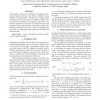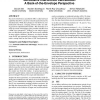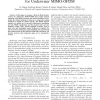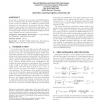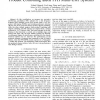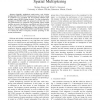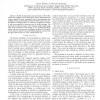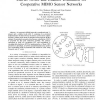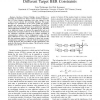105
Voted
ICASSP
2011
IEEE
14 years 4 months ago
2011
IEEE
In this paper, a Successive Interference Cancellation (SIC) receiver typically used for Code Division Multiple Access (CDMA) communications is developed to be used as piano chord ...
101
click to vote
HOTNETS
2010
14 years 7 months ago
2010
Successive interference cancellation (SIC) is a physical layer capability that allows a receiver to decode packets that arrive simultaneously. While the technique is well known in...
116
Voted
EJASP
2010
14 years 7 months ago
2010
In this paper we propose a block-by-block iterative receiver for underwater MIMO-OFDM that couples channel estimation with MIMO detection and channel decoding. In particular, the c...
113
click to vote
TWC
2008
15 years 19 days ago
2008
In this paper, we develop a random access scheme which combines the widely used binary exponential backoff (BEB) algorithm with a cross-layer tree algorithm (TA) that relies on suc...
92
Voted
IWCMC
2006
ACM
15 years 6 months ago
2006
ACM
A new way to determine the exact layer-wise SINR distribution for V-BLAST with successive interference cancellation at the receiver is presented. In contrast to previous publicati...
114
Voted
VTC
2006
IEEE
15 years 6 months ago
2006
IEEE
— In this contribution, we propose two successive interference cancellation (SIC) schemes for a fast frequency hopping (FFH) multiple access (MA) system using M-ary frequency shi...
115
Voted
GLOBECOM
2006
IEEE
15 years 6 months ago
2006
IEEE
— Spatially multiplexed multi-carrier code division multiplexing (SM-MC-CDM) communications with turbo coding is considered over correlated and uncorrelated multiple input multip...
91
Voted
GLOBECOM
2006
IEEE
15 years 6 months ago
2006
IEEE
— Mobile communication systems based on DS-CDMA suffer from multiple access interference (MAI), which limits the system capacity. Several techniques, such as beamforming with mul...
92
Voted
GLOBECOM
2006
IEEE
15 years 6 months ago
2006
IEEE
— A cooperative MIMO network is considered with Ns sensors and a collector node with Mc antennas. In a practical implementation of this network, the sensor carriers have relative...
106
click to vote
VTC
2007
IEEE
15 years 7 months ago
2007
IEEE
— Interleave Division Multiple Access (IDMA) is a promising air interface for future wireless networks. Optimization of access schemes regarding cross user aspects is also a topi...
